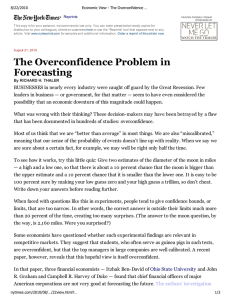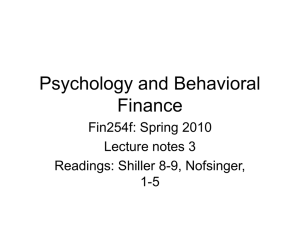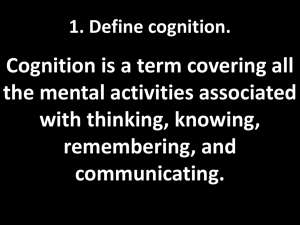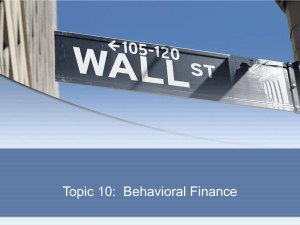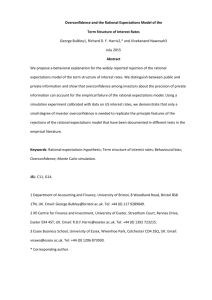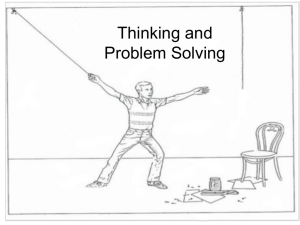Document 13724621
advertisement
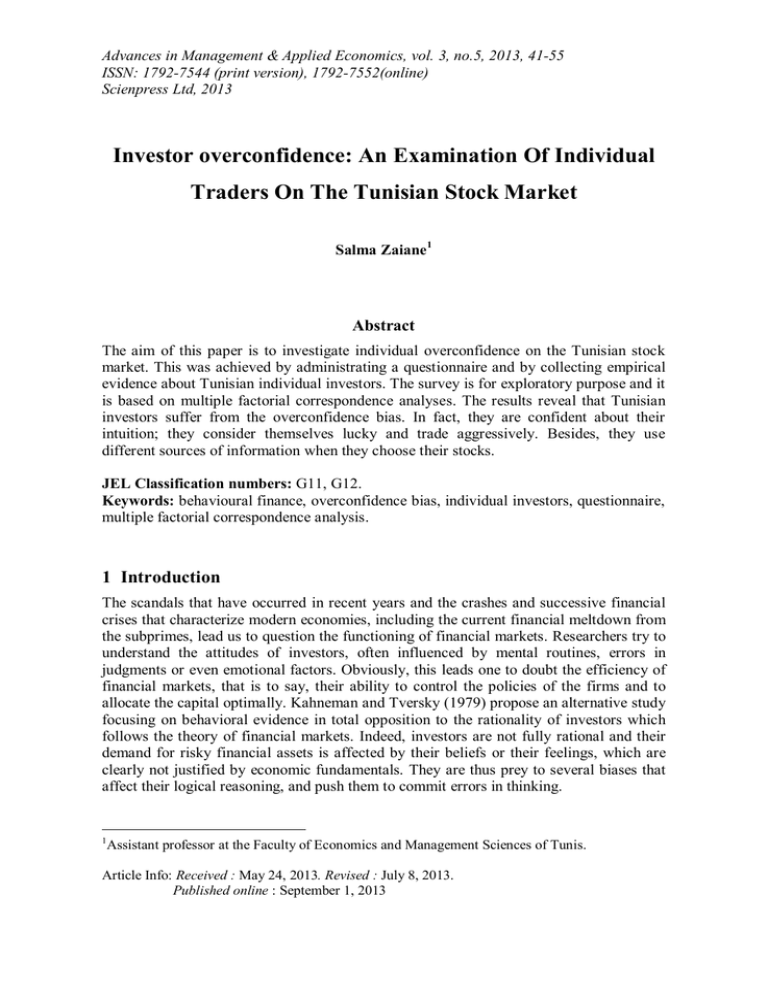
Advances in Management & Applied Economics, vol. 3, no.5, 2013, 41-55 ISSN: 1792-7544 (print version), 1792-7552(online) Scienpress Ltd, 2013 Investor overconfidence: An Examination Of Individual Traders On The Tunisian Stock Market Salma Zaiane1 Abstract The aim of this paper is to investigate individual overconfidence on the Tunisian stock market. This was achieved by administrating a questionnaire and by collecting empirical evidence about Tunisian individual investors. The survey is for exploratory purpose and it is based on multiple factorial correspondence analyses. The results reveal that Tunisian investors suffer from the overconfidence bias. In fact, they are confident about their intuition; they consider themselves lucky and trade aggressively. Besides, they use different sources of information when they choose their stocks. JEL Classification numbers: G11, G12. Keywords: behavioural finance, overconfidence bias, individual investors, questionnaire, multiple factorial correspondence analysis. 1 Introduction The scandals that have occurred in recent years and the crashes and successive financial crises that characterize modern economies, including the current financial meltdown from the subprimes, lead us to question the functioning of financial markets. Researchers try to understand the attitudes of investors, often influenced by mental routines, errors in judgments or even emotional factors. Obviously, this leads one to doubt the efficiency of financial markets, that is to say, their ability to control the policies of the firms and to allocate the capital optimally. Kahneman and Tversky (1979) propose an alternative study focusing on behavioral evidence in total opposition to the rationality of investors which follows the theory of financial markets. Indeed, investors are not fully rational and their demand for risky financial assets is affected by their beliefs or their feelings, which are clearly not justified by economic fundamentals. They are thus prey to several biases that affect their logical reasoning, and push them to commit errors in thinking. 1 Assistant professor at the Faculty of Economics and Management Sciences of Tunis. Article Info: Received : May 24, 2013. Revised : July 8, 2013. Published online : September 1, 2013 42 Salma Zaiane Empirical work and recent experimental research have confirmed that the errors of judgments made by individuals affect the behavior of security prices on financial markets. In fact, investors do not necessarily follow objective notions of financial loss or gain calculated mathematically. A key way, in which investors are victims, is the overconfidence bias. Indeed, they are tempted to overestimate the quality of information they have and their ability to interpret it. These features give them an illusion of control over the evolution of markets and distort their perception of risk, sometimes even encouraging them to take more risks. In this paper, we seek to better understand the human behavior that governs the dynamics of financial markets, studied through investor overconfidence on the Tunisian stock market. For that purpose, we use a questionnaire developed and administered to a Tunisian sample of individual investors. The rest of the paper is organized as follows: Section II presents a review of the literature of the overconfidence bias, and Section III presents the assumptions of our work. Empirical validation is described in Section IV and Section V is devoted to present the empirical results and their interpretation. Finally, Section VI contains the summary and the conclusion. 2 Literature Review Overconfidence bias is often regarded as the most prevalent judgment bias (Langer et al., 2010). It stems from the study of the calibration of subjective probabilities. This reflects how the confidence in an event corresponds to its actual probability of occurrence. In the psychological literature, there is no precise definition of overconfidence. In financial literature there are several findings that are often summarized under the concept of overconfidence: miscalibration, the better than average effect, illusion of control, and unrealistic optimism. - Miscalibration: It refers to the difference between the accuracy rate and the probability assigned (that a given answer is correct). This arises when the confidence interval around the investor’s private signal is tighter than it is in reality. This can be thought of as an irrational shift in perceived variance. According to Ben-David et al. (2010), miscalibrated people are those who overestimate the precision of their own forecasts, or underestimate the variance of risky processes; in other words, their subjective probability distributions are too narrow. Studies that analyze assessments of uncertain quantities using the fractile method usually find that people’s probability distributions are too tight (Lichtenstein et al., 1982), i.e. when subjects are asked to state a 90% confidence interval for some uncertain quantities, the percentage of true values that fall outside the interval, is higher than 10% (the percentage of surprises of a perfectly calibrated person). - Better than the average effect: Psychological research has established that, in general, people tend to have an unrealistically positive view of themselves. In fact, most of us, when comparing ourselves to a group (of co-student, co-workers, random participants), believe to be superior to an average representative of that group in various fields. A well known study of better than average effect carried out by Svenson (1981) demonstrated that, while comparing themselves with others, people generally believe themselves to be more skilful and less risky drivers than an average driver, without a prior definition or knowledge of the average driving skills. Taylor and Brown (1998) show that individuals Examination Of Individual Traders On The Tunisian Stock Market 43 feel they are better than others and this by taking into account the knowledge and the positive attributes of personality. In fact, the self serving bias2 makes people assign more responsibility for success and less for failure to themselves, while others are not given the same credit. - Illusion of control and unrealistic optimism: Langer (1975) defines the illusion of control as an expectancy of a personal success probability inappropriately higher than the objective probability would warrant. In fact, the existence of illusion of control in purely chance driven tasks has repeatedly been proven experimentally, with the participants convinced that their skill or past experience can influence the outcome of predicting the result of the task (Langer and Roth, 1975).Weinstein (1980) notes that this phenomenon is similar to the phenomenon of unrealistic optimism. According to this latter, people are particularly optimistic about future events to which they are personally in favor. Most people’s beliefs are biased in the direction of optimism (Kahneman and Riepe, 1998). In fact, Optimists underestimate the likelihood of bad outcomes over which they have no control. Several statistical studies have shown that individuals tend to overestimate the relevance of their knowledge (Alpert and Raiffa, 1982; Fischhoff, Slovic and Lichtenstein, 1977). Moreover, according to Griffin and Tversky (1992), 'experts' are more overconfident than inexperienced individuals. Odean (1998b) assumes that traders, insiders and market makers may unconsciously overestimate the precision of their information and rely on it more than is warranted, while traders display a better than average effect, evaluating their information as better than average than that of their peers. Such overconfidence of market participants may cause an increase in the trading volume. Daniel, Hirshleifer and Subrahmanyam (1998) show theoretically that investors are overconfident only towards private (and not public) signals. They propose a model of overconfidence and biased self-attribution of investors, i.e. people overestimate the degree to which they are responsible for their own success), where security market under and overreactions respectively follow public and private signals. This paper implies that volume should increase following positive returns when such returns build confidence. Moreover, researchers tend increasingly to study overconfidence using questionnaires or experimental studies. De Bondt (1998), for example, studied different measures of overconfidence (better than average effect, illusion of control and unrealistic optimism) using a large questionnaire. The author shows that investors are overly optimistic about the performance of shares that they themselves own but not about the level of the stock index in general. Maciejovsky and Kirchler (2002) note from an experimental study a greater overconfidence at the end of the experiment, when participants gain more experience and start to rely more heavily on their overestimated knowledge. Glaser, Langer and Weber (2010) show, from experimental studies related to the field of finance, that overconfidence of financial experts (professional traders and bankers) is higher than that of lay men (students). Bias et al. (2005) constructed an experimental asset market with varying private information and find that miscalibrated (overconfident) agents perform worse than their better calibrated counterparts. In addition, despite the fact that miscalibration itself is 2 See Alicke et al. (2005) et Skala (2008) for further details about this bias. 44 Salma Zaiane approximately the same for both men and women; it reduces trading performance in the experimental market, only for men who turn out to be more active traders than women. Glaser and Weber (2009), using data on 215 online investors who responded to a survey, find that “the better than average effect” is related to trading frequency. According to the authors, at the individual level, overconfident investors will trade more aggressively: the higher the degree of overconfidence of an investor, the higher his or her trading volume. Odean (1998b) calls this finding “the most robust effect of overconfidence”. Using experimental data, Deaves et al. (2008) observe that miscalibration-based overconfidence is positively related to trading activity, while Bias et al. (2002) find that miscalibrationbased overconfidence reduces trading performance. Blavatskyy (2008), using an experimental study, shows that the subjects exhibit average confidence in their own knowledge. In addition, confidence does not depend on their attitudes towards risk or ambiguity. By contrast, Benoit et al. (2009) use a test as part of an experimental study to test the better than average effect. Their results do not reject the hypothesis that the data is provided by perfectly rational and confident agents. Using two analytic methods, Parker and Stone (2010) examine the implication of two common measures – labelled overconfidence and unjustified confidence- showing how and where they can lead to different conclusions when they are used to prediction. Ifcher and Zarghamee (2011) conduct a laboratory experiment to identify the effect of positive affect on overconfidence. They find that overconfidence may explain the effect of positive affect on trading volume and the persistence of speculative bubbles. 3 Hypothesis In order to examine the existence of the overconfidence bias on the Tunisian stock exchange, we will test the following hypothesis: 3.1 Hypothesis 1: Overconfident Investors have Confidence in their Intuition "The trust in intuition" was confirmed by the work of Griffin and Tversky (1992), Daniel, Hirshleifer and Subrahmanyam (1998) and Odean (1998). Indeed, the personal implications have an influence on achieving favorable but random events (Langer and Roth, 1975). This can also be explained by the optimism bias. Indeed, subjects are optimistic about their fates (Bernartzi, Kahneman and Tversky, 1999). Kahneman and Riepe (1998) summarize the motivation of overconfidence as a combination of overconfidence and optimism that makes people overestimate their knowledge, underestimate risks and exaggerate in their ability to control the events. 3.2 Hypothesis 2: Overconfident Investors Trade more on the Stock Market Overconfident investors tend to trade more than rational investors. According to De Bondt and Thaler (1995), "The key behavioral factor needed to understand the trading puzzle is overconfidence." Odean (1998) and Gervais and Odean (2001) consider changes in trading volume as the first testable hypothesis of the theory of overconfidence. Gervais and Odean (2001) assume that overconfident traders achieve, on average, lower gains as they increase both trading and volatility which, in turn, negatively affects their Examination Of Individual Traders On The Tunisian Stock Market 45 trading results. They show that greater overconfidence leads to a higher trading volume and that this suggests that trading volume will be greater after market gains and lower after market losses. Moreover, Barber and Odean (2002) analyze trading volume and performance of a group of 1,600 investors who switched from phone based to online trading during the sample period. They find that those who switch to online trading perform well prior to going online and beat the market. Furthermore, they find that trading volume increases and performance decreases after going online. Other studies (Statman, Thorley and Vorkink, 2006; Chuang and Lee, 2006; Glaser and Weber, 2007, 2009)), find that trading volume increases after a series of high returns, since the success of investors increases their degree of overconfidence. These authors conclude that a high level of overconfidence leads to a significant trading volume. Using experimental studies, Biais et al. (2005) and Deaves et al. (2008) confirm that overconfidence is positively related to trading volume. 3.3 Hypothesis 3: Overconfident Investors make little use of Available Information The amount of information and the strength of that information influences people’s confidence in their decisions (Koriat, Lichtenstein and Fischhoff, 1980). Peterson and Pitz (1986) theorized that when one piece of information is given, judgments become extreme and confident, whereas when several pieces of useful information are given they conflict with each other and the resulting prediction is close to the average but with low confidence, which reduces overconfidence. Overconfident investors tend to use a minimum of information sources when they select their assets. In fact, overconfidence often leads to the non-use of available information (Fishhoff, 1982; Wickens and Holland, 2000). Griffin and Tversky (1992) suggest that the less informed investors suffer from overconfidence. This result is confirmed by Bloomfield, Libby and Nelson (1996). 3.4 Hypothesis 4: Overconfident Investors consider themselves Lucky According to Camerer and Lovello (1999), subjects entering the game (or the market) tend to overestimate their chances of success. Moreover, Weinstein (1980) and Taylor and Brown (1988) show that most people consider themselves better than average. They have excessive confidence in their own abilities and are optimistic about their future. According to Cooper, Woo and Dunkelberg (1988), entrepreneurs systematically overestimate their chances of success. Indeed, they showed that 33% of entrepreneurs had total confidence in their project and in their chance of success. 4 Empirical Studies 4.1 Objective The aim of our empirical studies is to test the existence of the overconfidence bias on a sample of individual investors on the Tunisian stock market, to study if they are victims of this bias in making their decisions. For that, we conducted a questionnaire survey. Indeed, the psychology, which can be defined as "the science of behavior”, must be taken into account by a method of investigation which can well describe the characteristics of 46 Salma Zaiane the investor. The questionnaire appears to be a useful tool in determining how individual errors affect aggregate behavior. We will particularly understand how the decisions of many individual investors are incorporated into prices on financial markets. 4.2 Data The subjects are targeted on the individual private stock investors in Tunis 3. We addressed our questionnaire to 150 Tunisian investors4. We used two methods of data collection (face to face interviews and mail survey). We got a response rate of 83% and a final sample of 125 investors. The survey was conducted in July 2008. The face-to-face interviews5 allowed us to respond directly to questions that respondents were asked about the issue itself. It also allowed us to better control the representativeness of the sample. Furthermore, we avoided expressing any opinion or any form of approval or disapproval, to avoid influencing the respondent. 4.3 Profile of Respondents Table 1 reports summary statistics for our sample of investors grouped by gender, age, education and business position. 73.6% of the subjects who responded to the questionnaire were men. This is easily understood since the number of men is higher than the number of women investing in the Tunisian stock market 6. A greater number of subjects (35.2%) were aged around 35~49 while 30.4% were aged between 25 and 34 years. 44% of the subjects have a bachelor degree while 44.8% have a master degree and above. We remark according to our sample, that the higher the degree of education, the more we invest in the stock market. Moreover, the proportion of executives is very high. In fact, they represent almost half of our sample (48%). Finally, most of the respondents belonged to the middle-income class with a monthly income between 600 and 2000 dinars7. 3 We note that commercial agents working at the front offices in stock market intermediary houses help as to contact the investors. 4 Several questionnaires were omitted since too many questions had been left unanswered. 5 Face to face interviews represent 70% of total interviews. We chose to perform our investigation on the big Tunis (Tunis, Ben Arous, Ariana), because the population of the big Tunis is heterogeneous and diversified and therefore, it gives us a greater depth of information. 6 See Dellagi et al. (2005, p. 5). 7 100 Tunisian Dinars = 66.7074US Dollars as of 26/01/2012. Examination Of Individual Traders On The Tunisian Stock Market 47 Table 1: Profile of respondents Variables Gender Age Education* Income** Business position Male 73.6 <25 12.8 low 11.2 Low 23.3 Merchant, Artisan, Entrepreneur 6.4 Response (in %) Female 26.4 25-34 35-49 30.4 35.2 Middle High 44.0 44.8 Middle High 58.4 18.4 Executive, Higher Middle intellectual management profession 48.0 20.8 50-60 12.8 >60 8.8 Employee Student Retired 8.0 9.6 7.2 *The education of low: high school or lower; middle: bachelor; high: master and above. **The income of low: < 600 dinars; middle: [600 dinars à 2000 dinars]; high: > 2000 dinars. 4.4 Methodology For our study, we used the “Sphinx” software (trial version, V5). This allowed us to design the questionnaire, to register the responses, and especially to process and analyze the data. We did not take missing data into consideration. Indeed, the terms "no answers" do not appear in the results: It could be either a deliberate refusal to answer certain questions or accidental omissions. The overconfidence bias is studied through the following four questions. For each question, one response modality is considered symptomatic of the psychological bias. If we accumulate three typical responses, we confirm the presence of the latter. We create a code for each question (variable) and each modality. This involves defining a label, that is to say an abstract in a smaller number of characters. Each theme is associated with a number. For example, the first question is associated with the code "Reason1. The coding variable is given in Table 2. Table 2 : Coding Variable Reason Why do you manage your portfolio by yourself? Duration How many months on average do you keep a line? Information How many sources of information do you use to select your stocks? Chance Would you say that every day, you are Reason1 : it’s more amusing Reason2 : you trust your intuitions Reason3 : other Duration1 : less than 3 months Duration2 : from 3 to 6 Duration3 : from 6 to 9 Duration4 : from 9 to 12 Duration5 : 12 and above Information1 : only one, we shouldn’t disperse Information2 : some of them, this is not fixed Information3 : many, because we can never be too informed Chance1 : lucky Chance2 : unlucky Chance3 : no opinion 48 Salma Zaiane After this coding, the data were entered on the Sphinx software. Finally, we presented the results of the analysis. 5 Results First, we will focus on the univariate analysis. Then, we will present the bivariate analysis. Finally, a multiple correspondence analysis will permit us to deepen our study and to represent, on the same graph, both active and status variables. 5.1 Univariate Analysis Tables 3, 4, 5 and 6 report the results of the univariate analysis of the various variables of the overconfidence bias. The symptomatic modality of the bias is set in gray. Reason Reason1 Reason2 Reason3 Total Table 3 : « Reason » Number of % observations 26 21.3% 81 66.4% 15 12.3% 122 100% Table 5 : « Information » Information Number of % observations Information1 9 7.2% Information2 47 37.6% Information3 69 55.2% 125 100% Total Table 4 : « Duration » Duration Number of (in months) observations Duration1 35 Duration2 25 Duration3 19 Duration4 2 Duration5 27 108 Total Table 6 : « Chance » Chance Number of observations Chance1 40 Chance2 18 Chance3 53 111 Total % 32.4% 23.1% 17.6% 1.9% 25.0% 100 % 36.0% 16.2% 47.7% 100% We observe from Table 3 that 66.4% of the respondents have confidence in their intuition against 21.3% who find amusement in managing their portfolios by themselves (Hypothesis 1 is thus confirmed). This was confirmed by the work of Langer and Roth (1975) and Daniel, Hirshleifer and Subrahmanyam (1998). Table 4 shows that 32.4% of the subjects retained, on average, their securities within 3 months (16.6% of them retain their stocks only one month). This is consistent with the studies of Odean (1998), Barber and Odean (2001), Gervais and Odean (2001), Chuang and Lee (2006) and Statman et al. (2006) (Hypothesis 2 is thus confirmed). Table 5 shows that 7.2% of the respondents use a single source of information to choose their securities against 55.2% that use several sources of information in the selection of their securities. This can be explained by the large number of graduates (Master and above represent 44.8%) and senior intellectuals executives (48%) in our sample. In addition, apart from the advice of his broker, the investor can use more and more Internet and newspapers to decide on the choice of his securities. (Hypothesis 3 is rejected). Examination Of Individual Traders On The Tunisian Stock Market 49 However, intensive use of information can also lead to overconfidence. Oskamp (1965) find that more information increases overconfidence via increasing confidence and not increasing accuracy. According to Slovic et al. (1977), from a certain level of information, the accuracy of predictions decreases but confidence continues to grow. Guiso and Jappelli (2005) show that overconfident investors collect a lot of information and base their decisions on it. Confidence seems to increase with the magnitude of the available information. This result was confirmed by Tsai et al. (2008), who conclude from three experimental studies that the confidence level increases with the amount of the available information. We note from Table 6 that 36% of the respondents consider themselves lucky against 16.2% who consider themselves unlucky (Hypothesis 4 is confirmed). Thus, we can conclude that Tunisian individual investors suffer from the overconfidence bias. A further study using bivariate and multivariate analysis seems to be interesting. It will allow us to confirm the obtained results. 5.2 Bivariate Analysis We note from the histogram (Figure 1), crossing variables "reason" and "gender", that men tend to be more overconfident than women. Indeed, 76.5% of men have confidence in their intuitions against only 23.5% of women. This result confirms those of Beyer (1999), Biais et al. (2005) and Barber and Odean (2001). In addition, confidence seems more important for those having higher intellectual professions (55.6%) and those having a master's level and above (45.7%). RAISON x Sexe Reason x Gender 81 76,5% 69,2% 23,5% 0 30,8% C' est plus It’s more amusant amusing G Féminin Female 60,0% 40,0% Vous avez You trust confiance dans vos your intuitions intuitions Masculin Male Autre Other Figure 1: A cross between « Reason » and « Gender » variables 50 Salma Zaiane 5.3 Multivariate Analysis The histogram of the eigenvalues is presented in Table 7. These represent the inertia (or variance) for each axis. Table 7 : Histogram of eigenvalues Eigenvalues % Explained 0.334 18.170 0.311 16.965 0.287 15.635 0.257 13.978 0.222 12.107 0.214 11.660 0.177 9.638 0.029 1.576 0.005 0.270 Number 1 2 3 4 5 6 7 8 9 Cumuative % 18.170 35.135 50.770 64.748 76.856 88.516 98.154 99.730 100.000 We can work with the first two axes as they render the maximum of the initial information (35.13%). Two sets of parameters are used to interpret the results, complementing the information given by the coordinates of the elements on the factorial axes: - The contributions (or absolute contributions) that describe the importance of the modality for the interpretation of the axis. - The square cosine (or relative contributions) that describe the importance of the axis for the interpretation of the modality. These settings are found in Table 8. Table 8: Main parameters of the correspondence analysis Reason1 Reason2 Reason3 Information1 Information2 Information3 Chance1 Chance2 Chance3 Sex F Sex M axis1 1.174 -0.110 -1.322 0.072 0.072 0.082 -0.500 1.759 -0.198 -0.540 0.195 Coordinates axis2 axis3 -0.751 -0.093 -0.149 0.344 -0.637 0.788 0.063 1.139 0.060 -0.308 0.059 0.063 0.087 -0.764 -0.362 -0.610 0.059 0.803 -1.191 0.081 0.433 -0.037 Contributions (%) axis1 axis2 axis3 22.239 9.743 0.163 41.208 1.114 6.379 16.279 4.047 6.716 0.332 1.498 7.242 1.756 7.007 2.773 3.361 10.179 0.169 6.197 0.200 16.853 34.556 1.564 4.830 1.288 0.124 24.644 5.977 31.123 0.156 2.166 11.476 0.089 Squared Cosine (%) axis1 axis2 axis3 0.366 0.150 0.002 0.022 0.040 0.212 0.242 0.056 0.086 0.000 0.000 0.100 0.003 0.002 0.056 0.008 0.004 0.005 0.122 0.004 0.286 0.530 0.022 0.064 0.030 0.003 0.499 0.104 0.505 0.002 0.101 0.501 0.004 Moreover, an interpretation of the first two factorial axes is possible by analyzing the positive and negative contributions of each axis (Table 9). Examination Of Individual Traders On The Tunisian Stock Market 51 Table 9: Contributions Table for the first two axes Axis1 Axis 2 (+19.14%) (+17.79%) Chance2 +35.97% Female +27.45% Positive Contributions Reason1 +25.64% Information1 +15.35% Information1 +8.99% Reason3 +14.67% Male +1.05% Reason1 +6.14% Information2 +4.46% Raison3 -14.28% Male -10.23% Negative Contributions Chance1 -6.72% Information3 -10.07% Female -2.90% Raison2 -10.06% Reason2 -1.64% Chance1 -0.79% Chance3 -1.43% Chance2 -0.04% Reason1 : It’s more amusing- Reason2 : You trust your intuitions - Reason3 : Other Information1 : Only one, we shouldn’t disperse - Information2 : Some of them, this is not fixed - Information3 : Many, because we can never be well informed – Chance1 : Lucky Chance2 : Unlucky - Chance3 : No opinion. - Interpretation of axis 1 It can be seen from Exhibit 9 that the first factorial axis (comprising 19.14% of inertia, that is to say, of the total information in the analysis), is the most important axis of the analysis, regrouping on one side (negative side) lucky investors and on the other side (positive side) the unlucky ones. The lucky ones seem to trust their intuition. - Interpretation of axis 2 Exhibit 9 informs as about the second factorial axis (comprising 17.79% of inertia). This area gathers on one side (the negative side) the confidents. These are men who have confidence in their intuitions, use multiple information and consider themselves lucky. On the other side (the positive side), this area includes the non-confidents that are women and use a single piece of information. Thus, this axis contrasts well the confidents with the non-confidents. - Interpretation of the factorial design The correspondence analysis allows us to represent graphically groupings of modalities involved in the analysis. Thus, we can have a graphic illustration of the individual investors (Figure 2). The modalities of the status variables are positioned closer to the modalities of opinion that resemble them the most, that is to say which are the most chosen by the same individuals. 52 Salma Zaiane Axe 2 (17.79%) Axis 2 (17.79%) I1 R3 S1 R1 I2 C3 Axe 1 (19.14%) Axis1 (19.14%) C2 C1 R2 I3 S2 Figure 2: Factorial design -Axis1-Axis2The map shows the position of 11 modalities and coordinates of 108 observations. 39.93% of the variance is explained by two axes. The non-answers are ignored. R1 : It’s more amusing- R2 : You trust your intuitions - R3 : Other - I1 Only one, we shouldn’t disperse - I2 : Some of them, , it’s not fixed - I3 : Many, we can never be well informed- C1 : Lucky - C2 : Unlucky - C3 : No opinion - S1 : female - S2 : male. The factorial design formed by the first two axes shows interesting combinations between the modalities of the analysis. These are close if the individuals who take one or other of these modalities are not distinguishable for other variables: they form a group, and the distance involved in the distinction between these two modalities, do not disturb the cohesion of the group. We can see, from Figure 2, the formation of a homogeneous group (factorial cloud). This group consists of overconfident investors. Indeed, by projecting on this chart the four variables related to the overconfidence bias and the status variable (gender), we find that from the side of investors who trust their intuition, are placed in their majority, men that are lucky and use multiple information sources. 6 Conclusion Human decision making does not seem to conform to rationality and market efficiency, but exhibits certain behavioral biases that are clearly counter-productive from the financial perspective. Examination Of Individual Traders On The Tunisian Stock Market 53 In this paper, we tested the presence of the overconfidence bias on the Tunisian stock market. For that, we administered a questionnaire to a group of individual investors, to consider whether they are victims of this bias in their decision making. The results indicate that individual investors on the Tunisian stock exchange suffer from the overconfidence bias. In fact, they trust their intuition; they consider themselves lucky and trade their securities in an aggressive manner. Moreover, they use multiple information sources to select their stocks. Thus, these investors tend to overestimate the quality of information they have and their ability to interpret it. These features give them an illusion of control over the evolution of markets and distort their perception of risk. Besides, another interesting study could be made from the same research framework; it is to test the presence of other psychological biases such as herding, loss aversion, mental accounting and anchoring. Further research should further investigate overconfidence in the context of an experimental approach focusing on individual investment (Dittrich et al., 2001). Also, further research on the relation between overconfidence and personal traits, such as attribution styles or positive affects, is needed to learn how certain characteristics trigger overconfidence (Ifcher and Zarghamee, 2010). References [1] M.D. Alicke., M.L. Klotz., D.L. Breitenbecher., T.J. Yurak and D.S. Vredenburg, Personal Contact, Individuation and the Better-Than-Average Effect, Journal of Personality and Social Psychology, 68(5), 1995, 804–825. [2] M. Alpert, and H. Raiffa, A progress report on the training of probability assessors, Judgment under uncertainty: Heuristics and biases, in Kahneman, D., Slovic, P., Tversky, A., Cambridge University Press, 1982. [3] B.M. Barber, and T. Odean, Boys will be boys: Gender, overconfidence, and common stock investment, The Quarterly Journal of Economics, 116(1), 2001, 261292. [4] B.M. Barber, and T. Odean, Trading is hazardous to your wealth: The common stock investment performance of individual investors, Journal of Finance, 55, 2001, 773-806. [5] I. Ben-David, J.R. Graham, and C.R. Harvey, Managerial miscalibration, SSRN Working Paper, (2010). [6] J.P. Benoît, J. Durba, and D. Moore, Does the better than average effect shows that people are overconfident?: An experiment, SSRN Working Paper, (2009). [7] A.V. Benos, Aggressiveness and survival of overconfident traders, Journal of Financial Markets, 1, 1998, 353-383. [8] S. Bernartzi, D. Kahneman, and R. Thaler, Optimism and overconfidence in asset allocation decisions, news.morningstar.com, (1999). [9] Beyer, P., Gender differences in the accuracy of self-evaluations of performance, Journal of Personality and Social Psychology, 59(5), 1999, 960-970. [10] B. Biais, D. Hilton, K. Mazurier, and S. Pouget, Judgmental overconfidence, self monitoring and trading performance in an experimental financial market, Review of Economic Studies, 72, 2005, 287-312. [11] P.R. Blavatskyy, Betting on own knowledge: Experimental test of overconfidence, SSRN Working Paper W358, 2008. 54 Salma Zaiane [12] R. Bloomfield, R. Libby, and M.W. Nelson, Communication of confidence as a determinant of group judgment accuracy, Organizational Behavioural Decision Processes, 68(3), 1996, 287-300. [13] J. Caballé, and J. Sàkovics, Speculating against an overconfident market, Journal of Financial Markets, 6, 2003, 199-225. [14] C.F. Camerer, and D. Lovello, Overconfidence and excess entry: An experimental approach, American Economic Review, 89(1), 1999, 306-318. [15] W.I. Chuang, and B.S, Lee, An empirical evaluation of the overconfidence hypothesis, Journal of Banking and Finance, 30(9), 2006, 2489-2515. [16] A.C. Cooper, C.Y. Woo and W.C. Dunkelberg, Entrepreneurs’ perceived chances for success, Journal of Business Venturing, 3, 1988, 97-108. [17] K. Daniel, D. Hirshleifer, and A. Subrahmanyam, Investor Psychology and Security Market Under- and Overreactions, Journal of Finance, 53(5), 1998, 1839-1885. [18] F.M. De Bondt, 1998, A portrait of the individual investor, European Economic Review, 42(3-5), p. 831-844. [19] F.M. De Bondt, and R.H. Thaler, Financial decision making in markets and firms: A behavioural perspective, in R. A. Jarrow, V. Maksimovic, end W.T. Ziemba, ed.: Handbooks in operations research and management science, Finance, 9, 1995, 385410 (Elsevier). [20] R. Deaves, E. Luders, and G.Y Luo, An experimental test of overconfidence and gender on trading activity, Review of Finance, 2008, ref 023V1. [21] H. Dellagi., S. Hammami, and K. Ben Ahmed, Le comportement de l’investisseur tunisien: Sondage réalisé auprès des souscripteurs à l’occasion de l’OPV SOTRAPIL, 2001, www.cmf.org.tn. [22] D. Dittrich, W. Guth, and B. Maciejovsky, Overconfidence in investment decision: an experimental approach, CESIFO Working Paper W626, (2001). [23] B. Fishhoff, For those condemned to study the past: Heuristics and biases in hindsight, in Kahneman, D., Slovic, A. et Tversky, A., Judgment under uncertainty: heuristics and biases, 1982, Cambridge: Cambridge University Press. [24] B. Fischhoff, S. Lichtenstein, and P. Slovic, Knowing with certainty: The appropriateness of extreme confidence, Journal of Experimental Psychology, 3(4), 1977, 552-556. [25] M. Glaser, and M. Weber, Overconfidence and trading volume, Geneva Risk and Insurance Review, 2007, 32(1), 2007, 1-36. [26] M. Glaser, and M. Weber, Which past returns affect trading volume?, Journal of Financial Markets, 12(1), 2009, 1-31. [27] M. Glaser, M. Weber, and T. Langer, “Overconfidence of professional and lay men: Individual differences within and between tasks?”, SSRN Working Paper, (2010). [28] D. Griffin, and A., Tversky, The weighing of evidence and the determinants of confidence, Cognitive psychology, 24, 1992, 411-435. [29] L. Guiso, and T. Jappelli, Awareness and stock market participation, Review of Finance, 9(4), 2005, 537-567. [30] J. Ifcher, and H. Zarghamee, Positive affect and overconfidence: A laboratory investigation, SSRN Working Paper,(2011). [31] D. Kahneman, and M. Riepe, Aspects of Investor Psychology, Journal of Portfolio Management, 24, 1998, 52-65. [32] D. Kahneman, and A. Tversky, Judgment under uncertainty: Heuristics and biases, Science, 185, 1974, 1124-1131. Examination Of Individual Traders On The Tunisian Stock Market 55 [33] D. Kahneman, and M. Riepe, Aspects of Investor Psychology, Journal of Portfolio Management, 24, 1998, 52-65. [34] E. Kirchler, and B. Maciejovsky, Simultaneous over and underconfidence : Evidence from experimental asset markets, Journal of Risk and Uncertainty, 25(1), 2002, 65-85. [35] Koriat, A., Lichtenstein, S. and Fischhoff, B., Reasons for confidence, Journal of Experimental Psychology: Human Learning and Memory, 6, 1980, 107-18. [36] E.J. Langer, The illusion of control, Journal of Personality and Social Psychology, 32, 1975, 311-328. [37] E.J. Langer,. and J. Roth, Heads i win, tail it’s chance: The illusion of control as a function of the sequence of outcomes in a purely chance task, Journal of Personality and Social Psychology, 32, 1975, 951-955. [38] S. Lichtenstein, B. Fischhoff, and L.D. Philips, Calibration of probabilities: The state of the art to 1980, in Daniel, Kahneman, Paul Slovic, and Amos Tversky, ed.: Judgement under uncertainty: heuristics and biases, p. 306-334 (Cambridge University Press), 1982. [39] B. Maciejovsky, and E. Kirchler, Simultaneous over and underconfidence : Evidence from experimental asset markets, Journal of Risk and Uncertainty, 25(1), 2002, 65-85. [40] T. Odean, Are investors reluctant to realize their losses?, Journal of Finance, 53 (5), 1998a, 1775-1798. [41] T. Odean, Volume, Volatility, Price, and Profit When All Traders Are above Average, Journal of Finance, LIII, 1998b, 1887–1934. [42] S. Oskamp, Overconfidence in case-study judgments, The Journal of Consulting Psychology, 29, 1965, 261-265. [43] A.M. Parker and E.R. Stone, Identifying the effects of unjustified confidence versus overconfidence: lessons learned from two analytic methods, SSRN Working Paper, (2010). [44] D.K. Peterson and G.F. Pitz, Effects of amount of information on predictions of uncertain quantities, Acta Psychologica, 61, 1986, 229-241. [45] D. Skala, Overconfidence in psychology and finance: an interdisciplinary literature review, Financial Markets and Institutions, 4, 2008, 33-50. [46] M. Statman, S. Thorley, and K. Vorkink, Investor overconfidence and trading volume, Review of Financial Studies, 19(4), 2006, 1531-1565. [47] O. Svenson, Are we all less risky and more skilful than our fellow drivers?, Acta Psychologica, 47, 1981, 143-148. [48] S. Taylor, and J.D Brown, Illusion and well being: A social psychology perspective and mental health, Psychological Bulletin, 103, 1988, 193-210. [49] C.I. Tsai, J. Klayman, and R. Hastie, Effects of amount of information on judgment accuracy and confidence, Organisational Behaviour and Human Decision Processes, 107, 2008, 97-105. [50] N.D.Weinstein, Unrealistic optimism about future life events, Journal of Personality and Social Psychology, 39(5), 1980, 806-820. [51] C.D. Wickens, and J.G. Holland, , Engineering psychology and human performance, (3rd edition). Upper Saddle River, NJ. Prentice Hall, (2000).

